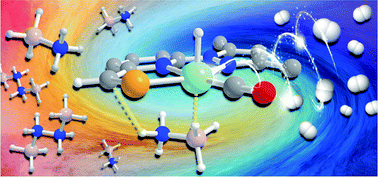Ammonia borane and hydrazine bis(borane) dehydrogenation mediated by an unsymmetrical (PNN) ruthenium pincer hydride: metal–ligand cooperation for hydrogen production†
Abstract
The five-coordinate RuII hydride (tBuPNN*)RuH(CO) (2) containing the dearomatized anionic form of the tridendate unsymmetrical pincer ligand tBuPNN {tBuPNN = 2-((di-tert-butylphosphino)methyl)-6-(3,5-dimethyl-1H-pyrazol-1-yl)pyridine} has been exploited as an ammonia borane (NH3·BH3, AB) and hydrazine bis(borane) (H3B·H2N–NH2·BH3, HBB) dehydrogenation catalyst in THF solution at ambient temperature. Complex 2 releases two H2 equivalents per AB monomer and 1.5 H2 equivalent per HBB monomer, with concomitant generation of the corresponding polymeric “spent fuels” [poly(borazylenes) or poly(aminoboranes), respectively]. Complex 2 has been found to have excellent catalytic activity, with recorded TOF values of 171 h−1 (AB) and 359 h−1 (HBB) at ambient temperature. The reaction has been studied experimentally through multinuclear [11B, 31P{1H}, and 1H] variable-temperature (VT) NMR spectroscopy, kinetic rate measurements and kinetic isotope effect (KIE) determination with deuterated AB isotopologues. It was found that the pincer backbone is directly involved in the catalytic process, with the presence of both protonated (tBuPNN) and deprotonated (tBuPNN*)− forms in solution. Cooperative catalysis involving the pincer methylenic side-arm and the metal center at the same time is the most likely reaction mechanism, on the basis of the collected experimental data and the computational analysis of the process at the DFT//MN15//SMD level of theory. An unprecedented dearomatization path stemming from the reduction of Cγ of the pyridine central ring has been found in the catalyst spent form formed at the end of the dehydrogenation process: (tBuPNN#)RuH(CO)·BH3 (4). Complex 4 was independently synthesized from the hydrido-chloro compound (tBuPNN)RuH(CO)Cl (1) with a large excess of NaBH4 at solvent reflux and it was characterized both in solution and in the solid state. The crystal structure revealed that the borane “ligand” bridges the Ru center and the pyridine N atom through one of its B–H bonds in a σ-BH agostic fashion. It can be formally considered as a (more stable) structural isomer of the hydride-borohydride complex (tBuPNN)RuH(CO)(η1-BH4) (3), with the H− and BH4− ligands trans to each other within the octahedral metal coordination sphere.

- This article is part of the themed collection: 2019 Sustainable Energy and Fuels HOT Articles


 Please wait while we load your content...
Please wait while we load your content...